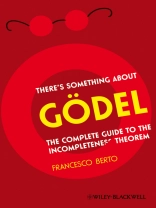Berto’s highly readable and lucid guide introduces students and the interested reader to Gödel’s celebrated Incompleteness Theorem, and discusses some of the most famous – and infamous – claims arising from Gödel’s arguments.
* Offers a clear understanding of this difficult subject by presenting each of the key steps of the Theorem in separate chapters
* Discusses interpretations of the Theorem made by celebrated contemporary thinkers
* Sheds light on the wider extra-mathematical and philosophical implications of Gödel’s theories
* Written in an accessible, non-technical style
* Offers a clear understanding of this difficult subject by presenting each of the key steps of the Theorem in separate chapters
* Discusses interpretations of the Theorem made by celebrated contemporary thinkers
* Sheds light on the wider extra-mathematical and philosophical implications of Gödel’s theories
* Written in an accessible, non-technical style
Inhaltsverzeichnis
Prologue.Acknowledgments.
Part I: The Gödelian Symphony.
1 Foundations and Paradoxes.
1 ‚This sentence is false‘.
2 The Liar and Gödel.
3 Language and metalanguage.
4 The axiomatic method, or how to get the non-obvious out of the obvious.
5 Peano’s axioms … .
6 … and the unsatisfied logicists, Frege and Russell.
7 Bits of set theory.
8 The Abstraction Principle.
9 Bytes of set theory.
10 Properties, relations, functions, that is, sets again.
11 Calculating, computing, enumerating, that is, the notion of algorithm.
12 Taking numbers as sets of sets.
13 It’s raining paradoxes.
14 Cantor’s diagonal argument.
15 Self-reference and paradoxes.
2 Hilbert.
1 Strings of symbols.
2 ‚… in mathematics there is no ignorabimus‘.
3 Gödel on stage.
4 Our first encounter with the Incompleteness Theorem … .
5 … and some provisos.
3 Gödelization, or Say It with Numbers!
1 TNT.
2 The arithmetical axioms of TNT and the ’standard model‘ N.
3 The Fundamental Property of formal systems.
4 The Gödel numbering … .
5 … and the arithmetization of syntax.
4 Bits of Recursive Arithmetic … .
1 Making algorithms precise.
2 Bits of recursion theory.
3 Church’s Thesis.
4 The recursiveness of predicates, sets, properties, and relations.
5 … And How It Is Represented in Typographical Number Theory.
1 Introspection and representation.
2 The representability of properties, relations, and functions … .
3 … and the Gödelian loop.
6 ‚I Am Not Provable‘.
1 Proof pairs.
2 The property of being a theorem of TNT (is not recursive!)
3 Arithmetizing substitution.
4 How can a TNT sentence refer to itself?
5 gamma
6 Fixed point.
7 Consistency and omega-consistency.
8 Proving G1.
9 Rosser’s proof.
7 The Unprovability of Consistency and the ‚Immediate Consequences‘ of G1 and G2.
1 G2.
2 Technical interlude.
3 ‚Immediate consequences‘ of G1 and G2.
4 Undecidable1 and undecidable2.
5 Essential incompleteness, or the syndicate of mathematicians.
6 Robinson Arithmetic.
7 How general are Gödel’s results?
8 Bits of Turing machine.
9 G1 and G2 in general.
10 Unexpected fish in the formal net.
11 Supernatural numbers.
12 The culpability of the induction scheme.
13 Bits of truth (not too much of it, though).
Part II: The World after Gödel.
8 Bourgeois Mathematicians! The Postmodern Interpretations.
1 What is postmodernism?
2 From Gödel to Lenin.
3 Is ‚Biblical proof‘ decidable?
4 Speaking of the totality.
5 Bourgeois teachers!
6 (Un)interesting bifurcations.
9 A Footnote to Plato.
1 Explorers in the realm of numbers.
2 The essence of a life.
3 ‚The philosophical prejudices of our times‘.
4 From Gödel to Tarski.
5 Human, too human.
10 Mathematical Faith.
1 ‚I’m not crazy!‘
2 Qualified doubts.
3 From Gentzen to the Dialectica interpretation.
4 Mathematicians are people of faith.
11 Mind versus Computer: Gödel and Artificial Intelligence.
1 Is mind (just) a program?
2 ‚Seeing the truth‘ and ‚going outside the system‘.
3 The basic mistake.
4 In the haze of the transfinite.
5 ‚Know thyself‘: Socrates and the inexhaustibility of mathematics.
12 Gödel versus Wittgenstein and the Paraconsistent Interpretation.
1 When geniuses meet … .
2 The implausible Wittgenstein.
3 ‚There is no metamathematics‘.
4 Proof and prose.
5 The single argument.
6 But how can arithmetic be inconsistent?
7 The costs and benefits of making Wittgenstein plausible.
Epilogue.
References.
Index.
Über den Autor
Francesco Berto teaches logic, ontology, and philosophy of mathematics at the universities of Aberdeen in Scotland, and Venice and Milan-San Raffaele in Italy. He holds a Chaire d’Excellence fellowship at CNRS in Paris, where he has taught ontology at the École Normale Supérieure, and he is a visiting professor at the Institut Wiener Kreis of the University of Vienna. He has written papers for American Philosophical Quarterly, Dialectica, The Philosophical Quarterly, the Australasian Journal of Philosophy, the European Journal of Philosophy, Philosophia Mathematica, Logique et Analyse, and Metaphysica, and runs the entries ‚Dialetheism‘ and ‚Impossible Worlds‘ in the Stanford Encyclopedia of Philosophy. His book How to Sell a Contradiction has won the 2007 Castiglioncello prize for the best philosophical book by a young philosopher.
Sprache Englisch ● Format PDF ● Seiten 256 ● ISBN 9781444315011 ● Dateigröße 1.6 MB ● Verlag John Wiley & Sons ● Erscheinungsjahr 2009 ● Ausgabe 1 ● herunterladbar 24 Monate ● Währung EUR ● ID 2388798 ● Kopierschutz Adobe DRM
erfordert DRM-fähige Lesetechnologie












